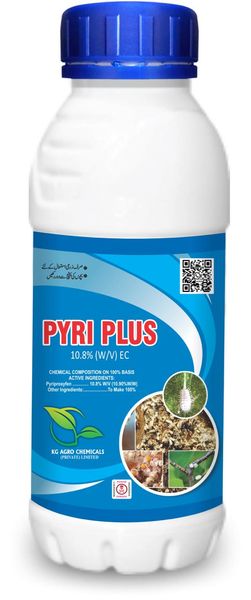
Pyri Plus
Pyriproxyfen 10.8% (W/V) EC
Pyriproxyfen is considered low in toxicity for humans and other mammals. If it gets in your eye, it can be mildly irritating. However, it was not irritating in skin tests with laboratory animals, even at high doses.
Laboratory animals exposed to moderate and high doses of pyriproxyfen were less active and gained weight less quickly. Some had diarrhea, unusual breathing, and loss of muscle control. Dogs fed a high dose of pyriproxyfen vomited occasionally during the first day. The dogs did not show any other signs after the first day. Dogs fed lower doses did not show any symptoms. Animals that inhaled pyriproxyfen had uneven breathing that recovered after one hour. Some animals had uncontrolled urination at the highest dose inhaled.
What happens to pyriproxyfen when it enters the body?
If eaten, pyriproxyfen is partially absorbed by the gut. Once inside, much of it is quickly broken down and leaves the body. In studies with rats, more than three quarters left the body within seven days. However, very small amounts of pyriproxyfen can be stored in fat and breast milk in the body. There are no studies for skin absorption of pyriproxyfen. However, other skin and developmental studies with pyriproxyfen suggest that less than one-third is absorbed through skin.
In one study, two groups of lactating goats were fed pyriproxyfen for five days. Extremely small amounts of pyriproxyfen were found in their milk. Two groups of laying hens were fed pyriproxyfen for eight days. A very small amount of the dose was found in the eggs, with most in the yolks.
Is pyriproxyfen likely to contribute to the development of cancer?
Mice and rats fed pyriproxyfen in their diets for 1.5 to 2 years did not show evidence of cancer after these studies. After several studies, pyriproxyfen has not shown evidence of altering or damaging genes. Based on these studies, the EPA has classified pyriproxyfen as not likely to cause cancer in humans.
Has anyone studied non-cancer effects from long-term exposure to pyriproxyfen?
In one study, dogs were fed moderate to high amounts of pyriproxyfen in their diet every day for one year. At the two highest dose levels, some animals became very thin and had fewer blood cells. Animals in all groups had increased cholesterol and liver weights. In another one-year study, dogs were fed small amounts of pyriproxyfen and there were no deaths or illnesses. In long-term feeding studies with rats, mice, and dogs, there were effects on the liver and kidneys.
In one study, rats fed high doses of pyriproxyfen during pregnancy did not have any effects on their young. Similarly exposed rabbits had reduced birth rates only at the highest dose tested. In another study with rats, some young had unusual skeletal and digestive changes.
Pyriproxyfen has been evaluated for its potential as an endocrine disruptor by the EPA. These studies did not find convincing evidence of interaction with the estrogen pathway. When male rats were fed pyriproxyfen for several weeks, there was some evidence of interaction with the androgen and thyroid pathways.
Are children more sensitive to pyriproxyfen than adults?
Children may be especially sensitive to pesticides compared to adults. Based on developmental studies, the EPA determined that infants and children are not more sensitive to pyriproxyfen than adults. However, young children may act in ways that put them at greater risk of being exposed. For example, they may spend more time near the floor. They may also be more likely to place their hands in their mouths after touching treated surfaces or pets.
What happens to pyriproxyfen in the environment?
Pyriproxyfen is rapidly broken down by sunlight and soil microbes. When exposed to sunlight, the half-life of pyriproxyfen is 6.8 to 16 days on soil surfaces and 3.7 to 21 days in water. In soil where microbes are present, the halflife is 6 to 9 days. Pyriproxyfen binds tightly to soil and is not dissolved easily in water. Based on these properties, it is not likely to move in soil toward ground water.
However, pyriproxyfen can contaminate surface water by spray drift or runoff and erosion of treated soil. Pyriproxyfen is stable in water alone and breaks down more slowly in water when it’s dark. In water with oxygen and microbes, the half-life is 16 to 23.1 days.
When applied to plants, there is evidence pyriproxyfen can move within leaves but that it does not move throughout plants easily. Pyriproxyfen has a low potential to create fumes. Care should be taken to avoid inhaling product mists or dusts.